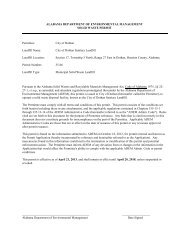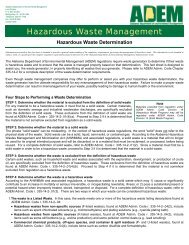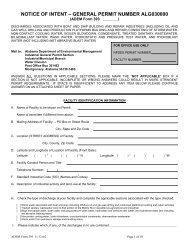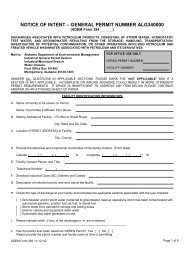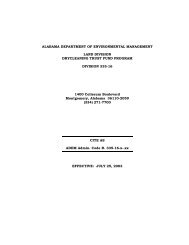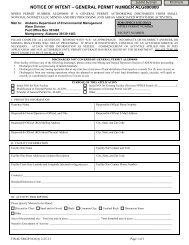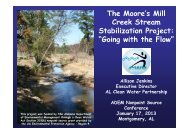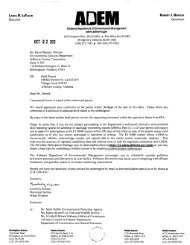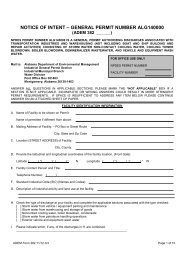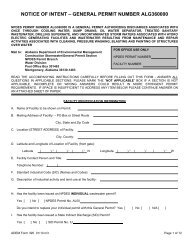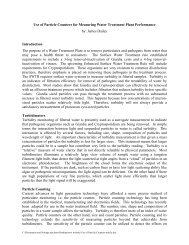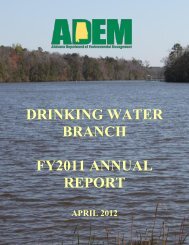NPDES Permit Number AL0025852 - Alabama Department of ...
NPDES Permit Number AL0025852 - Alabama Department of ...
NPDES Permit Number AL0025852 - Alabama Department of ...
You also want an ePaper? Increase the reach of your titles
YUMPU automatically turns print PDFs into web optimized ePapers that Google loves.
B. MONITORING AND RECORD KEEPING REQUIREMENTS<br />
I. Representative Sampling<br />
<strong>NPDES</strong> <strong>Permit</strong> <strong>Number</strong> <strong>AL0025852</strong><br />
Page 10 ono<br />
Sample collection and measurement actions shall be representative <strong>of</strong> the volume and nature <strong>of</strong> the monitored discharge<br />
and shall be in accordance with the provisions <strong>of</strong> this permit. The effluent sampling point shall be at the nearest accessible<br />
location just prior to discharge and after final treatment, unless otherwise specified in the permit.<br />
2. Measurement Frequency<br />
Measurement frequency reqUlrements found in Provision l.A shall mean:<br />
a. Seven days per week shall mean daily.<br />
b. Five days per week shall mean any five days <strong>of</strong> discharge during a calendar weekly period <strong>of</strong> Sunday through<br />
Saturday.<br />
c. Three days per week shall mean any three days <strong>of</strong> discharge during a calendar week.<br />
d. Two days per week shall mean any two days <strong>of</strong> discharge during a calendar week.<br />
e. One day per week shall mean any day <strong>of</strong> discharge during a calendar week.<br />
f. Two days per month shall mean any two days <strong>of</strong> discharge during the month that are no less than seven days apart.<br />
However, if discharges occur only during one seven-day period in a month, then two days per month shall mean any<br />
two days <strong>of</strong> discharge during that seven day period.<br />
g. One day per month shall mean any day <strong>of</strong> discharge during the calendar month.<br />
h. Quarterly shall mean any day <strong>of</strong> discharge during each calendar quarter.<br />
I. The <strong>Permit</strong>tee may increase the frequency <strong>of</strong> sampling, listed in Provisions 1.8.2.a through l.B.2.h; however, all<br />
sampling results are to be reported to the <strong>Department</strong>.<br />
3. Test Procedures<br />
For the purpose <strong>of</strong> reporting and compliance, <strong>Permit</strong>tees shall use one <strong>of</strong> the following procedures:<br />
a. For parameters with an EPA established Minimum Level (ML), report the measured value if the analytical result is at<br />
or above the ML and report "0" for values below the ML. Test procedures for the analysis <strong>of</strong> pollutants shall conform<br />
to 40 CFR Part 136 and guidelines published pursuant to Section 304(h) <strong>of</strong> the FWPCA, 33 U.S.C. Section 1314(h).<br />
If more than one method for analysis <strong>of</strong> a substance is approved for use, a method having a minimum level lower<br />
than the permit limit shall be used. If the minimum level <strong>of</strong> all methods is higher than the permit limit, the method<br />
having the lowest minimum level shall be used and a report <strong>of</strong> less than the minimum level shall be reported as zero<br />
and will constitute compliance, however should EPA approve a method with a lower minimum level during the term<br />
<strong>of</strong> this permit the <strong>Permit</strong>tee shall use the newly approved method.<br />
b. For pollutants parameters without an established ML, an interim ML may be utilized. The interim ML shall be<br />
calculated as 3.18 times the Method Detection Level (MDL) calculated pursuant to 40 CFR Part 136, Appendix 8.<br />
<strong>Permit</strong>tees may develop an effluent matrix-specific ML, where an effluent matrix prevents attainment <strong>of</strong> the<br />
established ML. However, a matrix specific ML shall be based upon proper laboratory method and technique.<br />
Matrix-specific MLs must be approved by the <strong>Department</strong>, and may be developed by the <strong>Permit</strong>tee during permit<br />
issuance, reissuance, modification, or during compliance schedule.<br />
In either case the measured value should be reported if the analytical result is at or above the ML and "0" reported for<br />
values below the ML.<br />
c. For parameters without an EPA established ML, interim ML, or matrix-specific ML, a report <strong>of</strong> less than the<br />
detection limit shall constitute compliance if the detection limit <strong>of</strong> all analytical methods is higher than the permit<br />
limit. For the purpose <strong>of</strong> calculating a monthly average, "0" shall be used for values reported less than the detection<br />
limit.<br />
The Minimum Level utilized for procedures a and b above shall be reported on the <strong>Permit</strong>tee's DMR. When an EPA<br />
approved test procedure for analysis <strong>of</strong> a pollutant does not exist, the Director shall approve the procedure to be used.<br />
4. Recording <strong>of</strong> Results<br />
For each measurement or sample taken pursuant to the requirements <strong>of</strong> this permit, the <strong>Permit</strong>tee shall record the<br />
following information:<br />
a. The facility name and location, point source number, date, time and exact place <strong>of</strong> sampling;



